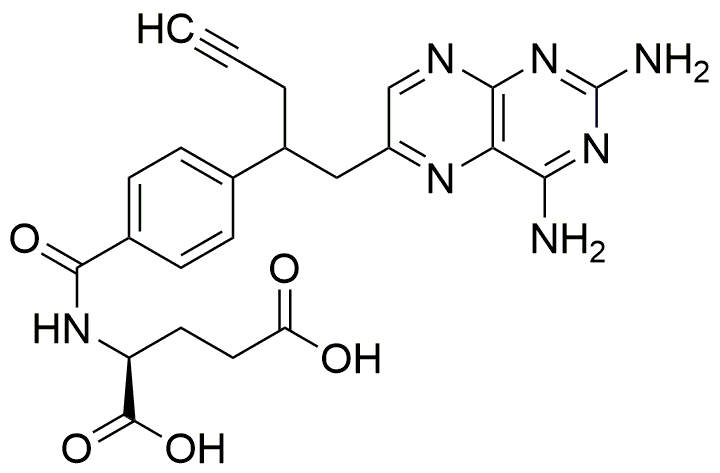Pralatrexate is widely utilized in research focused on:
- Cancer Treatment: Primarily used in the treatment of peripheral T-cell lymphoma, pralatrexate acts as an antifolate, inhibiting cancer cell growth by interfering with DNA synthesis.
- Pharmaceutical Development: It serves as a critical compound in developing new cancer therapies, allowing researchers to explore combination treatments that enhance efficacy and reduce side effects.
- Clinical Trials: Frequently involved in clinical studies, pralatrexate helps evaluate its effectiveness and safety in various cancer types, providing valuable data for oncologists.
- Research on Drug Resistance: Utilized to study mechanisms of drug resistance in cancer cells, aiding in the development of strategies to overcome resistance and improve treatment outcomes.
- Biomarker Identification: Plays a role in identifying biomarkers for patient stratification, helping clinicians tailor treatments based on individual responses to therapy.
General Information
Properties
Safety and Regulations
Applications
Pralatrexate is widely utilized in research focused on:
- Cancer Treatment: Primarily used in the treatment of peripheral T-cell lymphoma, pralatrexate acts as an antifolate, inhibiting cancer cell growth by interfering with DNA synthesis.
- Pharmaceutical Development: It serves as a critical compound in developing new cancer therapies, allowing researchers to explore combination treatments that enhance efficacy and reduce side effects.
- Clinical Trials: Frequently involved in clinical studies, pralatrexate helps evaluate its effectiveness and safety in various cancer types, providing valuable data for oncologists.
- Research on Drug Resistance: Utilized to study mechanisms of drug resistance in cancer cells, aiding in the development of strategies to overcome resistance and improve treatment outcomes.
- Biomarker Identification: Plays a role in identifying biomarkers for patient stratification, helping clinicians tailor treatments based on individual responses to therapy.
Documents
Safety Data Sheets (SDS)
The SDS provides comprehensive safety information on handling, storage, and disposal of the product.
Product Specification (PS)
The PS provides a comprehensive breakdown of the product’s properties, including chemical composition, physical state, purity, and storage requirements. It also details acceptable quality ranges and the product's intended applications.
Certificates of Analysis (COA)
Search for Certificates of Analysis (COA) by entering the products Lot Number. Lot and Batch Numbers can be found on a product’s label following the words ‘Lot’ or ‘Batch’.
*Catalog Number
*Lot Number
Certificates Of Origin (COO)
This COO confirms the country where the product was manufactured, and also details the materials and components used in it and whether it is derived from natural, synthetic, or other specific sources. This certificate may be required for customs, trade, and regulatory compliance.
*Catalog Number
*Lot Number
Safety Data Sheets (SDS)
The SDS provides comprehensive safety information on handling, storage, and disposal of the product.
DownloadProduct Specification (PS)
The PS provides a comprehensive breakdown of the product’s properties, including chemical composition, physical state, purity, and storage requirements. It also details acceptable quality ranges and the product's intended applications.
DownloadCertificates of Analysis (COA)
Search for Certificates of Analysis (COA) by entering the products Lot Number. Lot and Batch Numbers can be found on a product’s label following the words ‘Lot’ or ‘Batch’.
*Catalog Number
*Lot Number
Certificates Of Origin (COO)
This COO confirms the country where the product was manufactured, and also details the materials and components used in it and whether it is derived from natural, synthetic, or other specific sources. This certificate may be required for customs, trade, and regulatory compliance.


